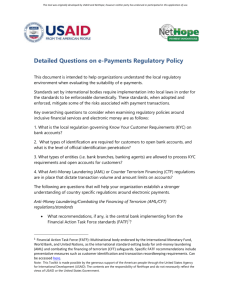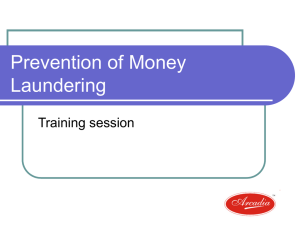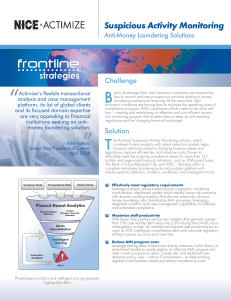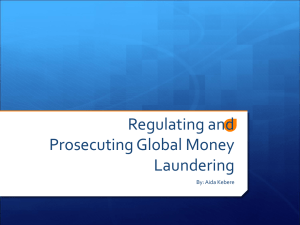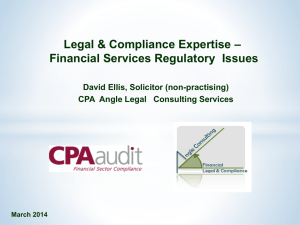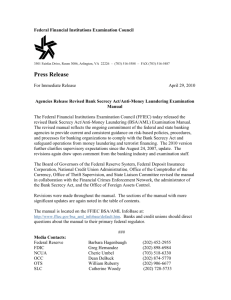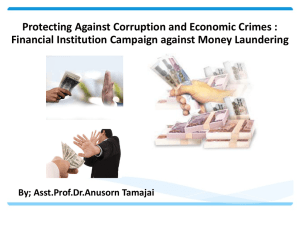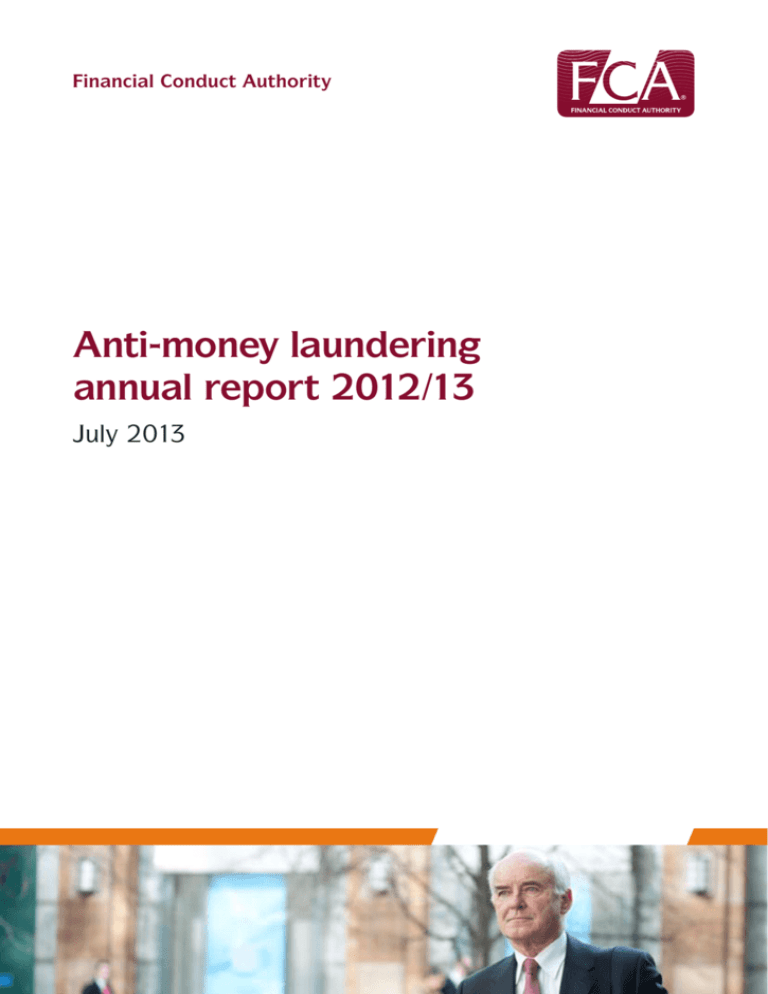
Financial Conduct Authority
Anti-money laundering
annual report 2012/13
July 2013
Anti-money laundering annual report 2012/13
Contents
Introduction3
1
Background4
2
What are the sources of money laundering risk?
5
3
What are our responsibilities on AML?
6
4
What is our approach?
7
5
How do we cooperate with other agencies
9
6
Levels of compliance
11
7
What are the current trends and emerging risks?
14
8
Future work
16
9
Conclusion 17
Financial Conduct Authority
July 2013
1
Anti-money laundering annual report 2012/13
Introduction
This report sets out our obligations relating to anti-money laundering, our approach to
carrying out those obligations, and the trends and emerging risks in money laundering that
we are seeing in the firms we regulate.
The discussion of trends and risks focuses on the ways in which the firms we regulate may
be vulnerable to being used by money launderers, rather than on the types of crime (such as
drug smuggling) from which the illicit funds are derived.
We intend to publish more reports on these issues in future.
Financial Conduct Authority
July 2013
3
Anti-money laundering annual report 2012/13
1.
Background
1.1
The Financial Conduct Authority (FCA) was established on 1 April 2013. Our overall objective
is to ensure that relevant markets work well. This is supported by three operational objectives,
which are to:
• protect and enhance the integrity of the UK financial system
• secure an appropriate degree of protection for consumers, and
• promote competition in the interests of consumers.
1.2
We are also the anti-money laundering (AML) regulator of many of the firms subject to the
Money Laundering Regulations 2007 (the MLR 20071). So we are responsible for supervising
how those firms comply with their AML obligations.
1.3
While carrying out our work we have a duty under the Financial Services and Markets Act 2000
(FSMA) to have regard to the importance of minimising how possible it is for firms to be used
for financial crime.
1.4
This is our first annual report on these issues. It explains our responsibilities, our approach to
carrying out our anti-money laundering duties, and the current and emerging trends we have
observed recently in the firms we regulate. We will publish annual reports on these issues,
looking at the sectors that we regulate.
1.5
As we noted in our Risk Outlook 2013, there has been increasing public interest in money laundering.
In its report ‘Drugs: Breaking the Cycle’, published in December 2012, the House of Commons
Home Affairs Select Committee suggested that we produce annual reports showing the prevalence
of money laundering within the UK financial sector. In response, we proposed publishing a report
on the performance of our duties under the MLR 2007, including some information on broader
money laundering trends affecting those sectors of the industry that we regulate. These reports
will complement those published by the Treasury on anti-money laundering supervision in the UK.
1.6
We will increase the transparency of our work where appropriate.2 Two new regulatory
principles given to us by FSMA make transparency a particular priority for us:
• the desirability of publishing information about regulated firms and individuals, and
• the requirement to carry out our functions as transparently as possible.
1.7
We are also committed to carrying out our responsibilities using a risk-based and proportionate
approach. We use this approach in all our work, at the authorisation or approval stage, as well as
in our supervision and enforcement work. We explain in Section 4 how we use this approach in
our anti-money laundering work.
1 The MLR 2007 implement the requirements of the Third EU Money Laundering Directive in the UK.
2See Journey to the FCA.
4
July 2013
Financial Conduct Authority
Anti-money laundering annual report 2012/13
2.
What are the sources of money laundering risk?
2.1
The most important risks that financial crime currently pose to our objectives are from money
laundering, breaches of the UK’s and other countries’ financial sanctions, terrorist financing,
investment fraud (boiler rooms and similar frauds, including the associated risk that the
fraudulent proceeds are then laundered) and bribery and corruption. This report focuses on
money laundering, financial sanctions breaches and terrorist financing.
2.2
The international nature of the UK financial markets, and the range of financial services
they offer, mean they are attractive to all types of business, both illegitimate and legitimate.
Globalisation has reinforced London’s position as a leading international financial centre. Also,
as we noted in the Risk Outlook, in current economic circumstances firms may opt for higher
risk funding sources, such as shareholdings from international sources where there may be
lower compliance with anti-money laundering standards.
2.3
Many of the firms we regulate have a global presence, with business and customers in many
countries. Some of those countries are assessed by non-governmental organisations3 as high
risk for financial crime. And the UK is seen as safe and attractive for many wealthy individuals,
including some from those high risk countries. This means that regulated firms may take more
risks over the sources of the funds they are prepared to accept, increasing the possibility that
they may be handling the proceeds of corruption or other crime.
2.4
At the same time, domestic organised crime continues to be a major concern. In 2012 the Home
Office estimated that domestic organised criminal gangs generated £20 billion to £40 billion
a year from the sale of narcotics, people smuggling and trafficking, and other illicit activities.
2.5
In 2007 the Treasury estimated that each year £10 billion of illicit funds passed through the
‘regulated sector’. The ‘regulated sector’ is all firms subject to the MLR 2007. Many of these,
e.g. lawyers, accountants and many money service businesses, are regulated by bodies other
than the FCA (see Section 5). Developments in technology and international travel have also
increased the risk of illicit funds being transmitted through FCA-regulated firms.
3 Such as Transparency International and Global Witness.
Financial Conduct Authority
July 2013
5
Anti-money laundering annual report 2012/13
3.
What are our responsibilities on AML?
6
3.1
The Financial Services Authority (FSA) had a statutory objective to reduce the extent to which
it was possible for a financial business to be used for financial crime. We do not have a
freestanding objective to reduce financial crime, but reducing the extent to which firms can be
used for financial crime is a priority as part of our objective to enhance the integrity of the UK
financial system. All firms authorised under FSMA are required to take steps to reduce the risk
that they may be used for financial crime.
3.2
As explained in section 1 above, the FCA is a supervisor under the MLR 2007. We are responsible
for ensuring that most authorised firms and all e-money institutions comply with the MLR
2007, with the exception of the likes of those undertaking purely general insurance business, or
mortgage or general insurance intermediary activity, which are not subject to the Regulations.
3.3
We are also responsible for what are known as ‘Annex I Financial Institutions’ such as financial
leasing companies, safe custody services and money broking. These are not authorised activities
but are subject to standalone anti-money laundering supervision by the FCA. There are around
350 Annex I Financial Institutions.
3.4
The Office of Fair Trading (OFT) is responsible for regulating consumer credit institutions until
1 April 2014. HM Revenue and Customs (HMRC) are the AML supervisors of money service
businesses (MSBs), including money transmitters and currency exchangers (where these
activities are not carried out by an FCA-authorised firm).
3.5
All the firms we regulate for anti-money laundering purposes are, under the MLR 2007, required
to operate the same AML standards in their businesses outside the European Economic Area
(EEA) as they do in the UK, to the extent permitted by local law. We supervise how they do
that, and we cooperate on this with other authorities.
July 2013
Financial Conduct Authority
Anti-money laundering annual report 2012/13
4.
What is our approach?
4.1
We focus our resources on firms that are particularly exposed to financial crime risk. We
prioritise protecting consumers (rather than regulated firms) and seeking out firms that are
being used for financial crime, particularly money laundering and bribery/corruption.
4.2
We aim to be proactive in solving any problems that we find, so we concentrate on identifying
current and emerging financial crime risks, and ensuring that firms are aware of their implications
and how to mitigate them. This means we can make sure that firms maintain and enhance their
systems and controls against financial crime. Our approach is intensive and intrusive, with an
emphasis on early intervention and credible deterrence where serious risks are identified. We
use a range of techniques, including detailed testing to determine whether firms are meeting
their legal and regulatory obligations.
How we supervise firms
4.3
Responsibility for AML supervision is shared between firm supervisors and a specialist financial
crime supervision team, whose resources are being increased from 17 to 22 staff by the end of
2013. Firm supervisors are often the first in the FCA to hear that a money laundering risk has
arisen in a firm, for example when firms notify them that their anti-money laundering controls
have failed. However, we also receive intelligence from a range of other sources, including law
enforcement, whistleblowers, consumers and the press. Intelligence from whistleblowers is
very valuable, particularly on money laundering controls in smaller firms, where supervisory
contact will generally be less frequent.
4.4
The specialist supervision team supports the firm supervisors in a number of ways. Some of this
work is highly resource-intensive, while other issues need much less specialist input. The types
of specialist support include:
• Dealing with cases of money laundering risk and/or serious weaknesses in firms’ anti-money
laundering controls (around 100 cases a year).
• Conducting Systematic Anti-Money Laundering Programme (SAMLP) assessments of
major banks. The SAMLP has been running since early 2012 and currently covers 14 major
retail and investment banks operating in the UK. These reviews are intrusive, involving
detailed testing and extensive interviewing of key staff responsible for the bank’s business,
for implementing anti-money laundering processes and for AML controls. We often visit
branches, as well as the operations of UK-incorporated firms outside the EEA, where they
are required to operate UK-equivalent AML standards. We have so far assessed and visited
five UK banks and conducted overseas work in Switzerland, Singapore and India for three
of them.
Financial Conduct Authority
July 2013
7
Anti-money laundering annual report 2012/13
• Carrying out thematic reviews on high risk issues, assessing around 20 firms each time.
We usually publish these reviews, assessing how well firms in general identify and mitigate
the money laundering risks they face, as well as guidance on good and poor practice. Our
recent thematic work on AML includes: Banks’ management of high money laundering
risk situations (June 2011); Banks’ defences against investment fraud (June 2012); and
Banks’ control of financial crime risks in trade finance (July 2013). In addition, we are due
to publish a review of AML and anti-bribery and corruption controls in asset management
firms later this summer.
• Assisting with the financial crime aspects of firm risk assessments carried out by firm
supervisors.
4.5
The specialist team’s work assesses financial crime systems and controls in around 150 firms a
year. Most of this focuses on anti-money laundering systems and controls.
4.6
As well as supervising anti-money laundering controls in individual firms, we also provide
guidance. Our Financial crime: a guide for firms sets out what firms can do to reduce their
financial crime risk and brings together all our guidance on financial crime, from our thematic
reviews and other work.
4.7
In the past twelve months we also have published newsletters and held external presentations
and briefing sessions to present the detailed findings of our thematic reviews and to hear
firsthand from firms. We will continue to hold these sessions, and we encourage firms to
continue to contribute to this process. We are also consulting on updating our financial crime
guide to reflect the good and poor practice that we found from this year’s thematic reviews
Engaging with firms and other organisations
4.8
Every two years we host a financial crime conference. The theme this year was ‘The financial
crime regime and the FCA’. The key messages were that:
• We will work in partnership with our law enforcement partners and with other regulators.
• We are closely involved in formulating policy, both in the UK and internationally. We are
particularly interested in promoting the risk-based approach to anti-money laundering
supervision. We believe this approach helps firms use their resources most effectively to
address the highest risks.
8
4.9
We host regular meetings with a number of the Money Laundering Reporting Officers (MLROs)
and Financial Crime Directors from a variety of FCA-authorised firms. The Treasury and the
British Bankers Association also attend. These meetings are useful for all involved, and we
want to expand them to ensure that all firms and sectors are represented. We also meet trade
associations to discuss emerging trends and policy issues.
4.10
We are a member of the Money Laundering Advisory Committee, co-chaired by the Treasury
and the Home Office, which brings together representatives from law enforcement, government,
industry and regulators to advise the Government on its approach to preventing money laundering
in the UK. This committee also reviews industry guidance before it is approved by the Treasury.
We also work with the Joint Money Laundering Steering Group, which produces guidance for the
financial services industry on preventing money laundering/combating terrorist financing.
July 2013
Financial Conduct Authority
Anti-money laundering annual report 2012/13
5.
How do we cooperate with other agencies?
Law enforcement
5.1
Alongside other agencies such as HMRC and the Serious Fraud Office, we work in partnership
with the Economic Crime Command (ECC) of the National Crime Agency (NCA).4 We attend the
ECC committees that determine its priorities and coordinate multi-agency action in response to
economic crime threats. We also have a seat on the ECC board.
5.2
The ECC currently focuses on fraud against the individual, public sector bodies or private sector
organisations. It has identified money laundering as one of four enablers for these frauds.
The ECC sees tackling money laundering as important for reducing serious organised and/or
complex economic crime and protecting the UK’s reputation and economy. Money laundering
will be a priority for the NCA.
5.3
We receive occasional reports on individual cases from law enforcement agencies about money
laundering investigations where there are concerns that FCA-regulated firms may have facilitated
money laundering, either knowingly or though ineffective anti-money laundering procedures. We
work with law enforcement to encourage their financial investigators to pass more intelligence to
us about poor AML practice by firms, to help us focus our supervisory efforts.
Other regulators
5.4
We also collaborate with other anti-money laundering supervisors. The Anti-Money Laundering
Supervisors forum was set up by the supervisory authorities specified in the MLR 20075 to share
views on current and emerging concerns and best practice. We play a key role in this forum, as
well as chairing the public sector group within the forum.
5.5
We work particularly closely with HMRC, especially in relation to Money Service Businesses
(MSBs). This is because we regulate MSBs that provide money transmission services for consumer
protection purposes under the Payment Services Regulations 2009, but they have HMRC as
their anti-money laundering supervisor. So these firms need either to seek FCA authorisation
(for larger firms) or register with us (smaller firms), as well as being registered with HMRC for
AML supervision purposes. We regularly share information with HMRC about the firms we
both oversee, and arrange joint visits where appropriate. The particular risks posed by MSBs
are discussed in Section 7.
4 The NCA currently exists in shadow form and will be officially launched on 1 October 2013.
5 Bodies that have responsibilities as Anti-Money Laundering Supervisors are set out in the Money Laundering
Regulations 2007. They are a mix of public sector supervisors and professional bodies. The Regulations list the
public sector bodies in Regulation 23, http://www.legislation.gov.uk/uksi/2007/2157/regulation/23/made and
professional bodies in Schedule 3, http://www.legislation.gov.uk/uksi/2007/2157/schedule/3/made.
Financial Conduct Authority
July 2013
9
Anti-money laundering annual report 2012/13
International
5.6
We support the Treasury, which leads the UK delegation to the Financial Action Task Force
(FATF – the global AML standard setting body), and the FATF itself. Our aim is to ensure that
international standards, including the FATF’s Recommendations, assessment methodologies,
guidance and typologies papers, promote an effective, proportionate and risk-based approach
to AML and combating terrorist financing (CTF).
5.7
Over the past year we have supported the Treasury on a number of initiatives at the FATF,
such as developing methodologies to assess how FATF member states comply with the FATF’s
Recommendations, and best practice and guidance papers on Politically Exposed Persons (PEPs,
i.e. individuals holding prominent public positions in jurisdictions other than the UK), corruption
and new payment products and services.6
5.8
At European level we are supporting the Treasury in the negotiation of the Fourth Money
Laundering Directive. We are also a member of the Anti-Money Laundering Committee (AMLC),
a sub-committee of the Joint Committee of the Joint European Supervisory Authorities (ESAs).
The AMLC helps the ESAs meet their obligations by supporting supervisory convergence
across the EU, providing expert input into the Commission’s AML/CTF work, and providing a
forum to exchange information and good practice. The AMLC is currently chaired by a senior
FCA employee. In 2012 the FSA chaired an AMLC working group that published a report on
the implementation of the anti-money laundering aspects of the Second E-Money Directive.
The proposed Fourth Money Laundering Directive will delegate to the AMLC the drafting of
guidelines and binding technical standards on key parts of Europe’s AML/CTF regime.
5.9
In addition to our work in international AML forums, we also work closely with AML supervisors
in other jurisdictions. This may be through discussions in colleges of supervisors, where the
various supervisors of a globally active bank discuss key issues, which may include anti-money
laundering controls. We also have bilateral discussions with our overseas counterparts about
individual firms. For example, we worked very closely with the US authorities in 2012 over
their investigations into HSBC and Standard Chartered Bank. When we review banks’ overseas
operations, we work closely with the local supervisors.
5.10
However, we recognise that supervising global firms’ compliance with AML requirements is
challenging. Our SAMLP reviews, together with increasing our cooperation with overseas
supervisors, should help us in achieving this.
6 Section 7 explains how we are supporting the Government in their preparation of the National Risk Assessment, as part of the UK’s
compliance with the FATF Recommendations.
10
July 2013
Financial Conduct Authority
Anti-money laundering annual report 2012/13
6.
Levels of compliance
6.1
We supervise a large and diverse industry and cannot monitor all transactions in all firms, or
even in a single firm. However, our risk-based supervisory techniques (set out in Section 4) have
led us to conclude that the level of anti-money laundering compliance in financial services firms
is a serious concern.
Our thematic review findings
6.2
Our 2011 thematic review of Banks’ management of high money laundering risk situations
found that three quarters of the banks reviewed, including a number of major banks, were not
managing this risk effectively. Around a third of banks, including the private banking arms of
some major banking groups, appeared willing to accept very high levels of money laundering
risk if the immediate reputational and regulatory risk was acceptable.
6.3
Over half the banks we visited failed to apply meaningful enhanced due diligence (EDD)
measures in higher risk situations and so failed to identify or record adverse information about
the customer or the customer’s beneficial owner. Around a third of them dismissed serious
allegations about their customers without adequate review. More than a third of the banks
visited failed to put effective measures in place to identify customers as PEPs.
6.4
Three quarters of the banks in our sample failed to take adequate measures to establish the
legitimacy of the source of wealth and source of funds to be used in the business relationship.
This was of particular concern where the bank was aware of significant adverse information
about the customer’s or beneficial owner’s integrity.
6.5
Some banks had inadequate safeguards in place to mitigate relationship managers’ conflicts
of interest. At more than a quarter of banks visited, relationship managers appeared to be
too close to the customer to take an objective view of the business relationship. Many were
primarily rewarded on the basis of profit and new business, regardless of their anti-money
laundering performance. There were indications that some banks were willing to enter into very
high risk relationships without adequate controls when there were large profits to be made.
We concluded that it was likely that some banks were handling the proceeds of corruption and
other financial crime.
6.6
More recently, our thematic review of Banks’ control of financial crime risks in trade finance
found that most banks, including a number of major UK banks, were not giving adequate
attention to money laundering red flags in trade finance transactions. There was an inconsistent
approach to risk assessment and only a few banks had conducted a specific trade finance
money laundering risk assessment.
6.7
About half of the banks had no clear policy or procedures document for dealing with tradebased money laundering risks. As a result, some banks failed to implement adequate controls
Financial Conduct Authority
July 2013
11
Anti-money laundering annual report 2012/13
to identify potentially suspicious transactions. Many banks were unable to demonstrate that
money laundering risk had been taken into account when processing particular transactions. In
particular, trade processing staff in most banks made inadequate use of customer due diligence
information gathered by relationship managers or trade sales teams. In addition, systems and
controls over dual-use goods7 were inadequate at most banks. However, a minority of banks
used some innovative and effective techniques to assess money laundering risk in trade finance
transactions, which other banks could usefully follow.
6.8
The root cause of these problems is often a failure in governance of money laundering risk,
which leads, among other things, to inadequate anti-money laundering resources and a lack of
(or poor quality) assurance work across the firm. This often focuses on whether processes have
been followed rather than on the substance of whether good AML judgements are being made.
6.9
The weakness we see in firms’ dealings with high risk customers and PEPs is a serious and
persistent problem in firms of all sizes. However, this issue manifests itself in different ways in
different types of firm. Small firms often fail to collect enhanced due diligence information, as
required under the MLR 2007. Large firms, including those that have been subject to SAMLP
examinations, often collect adequate information but fail to assess it properly and/or make
poor judgements about the money laundering risk this information exposes, particularly where
potential profits are high.
6.10
We also find weaknesses in firms of all sizes when they should be establishing and corroborating
high risk customers’ sources of wealth or funds. Too much reliance is often placed on customers’
own explanations, even when they are subject to serious and credible allegations of criminal
activity.
Our tools
6.11
6.12
We use a range of tools to ensure firms improve. These include: setting remedial plans; seeking
attestations from senior management that weaknesses have been remediated; using a Skilled
Person to test systems and controls, identify weaknesses, and, in some cases, remediate the
weaknesses identified; and considering enforcement action in appropriate cases.
Enforcement and intervention
We will use our enforcement powers in money laundering cases, where this is an effective
and proportionate use of our powers. We have taken the following recent enforcement action
against several firms and one individual for failing to manage the money laundering risk
presented by high risk customers and PEPs:
• Coutts & Co: £8.75m fine in March 2012 for weaknesses in AML controls over high risk
and PEP customers.
• Habib Bank AG Zurich: £525,000 fine in May 2012 for weaknesses in AML controls over
high risk and PEP customers. We also fined Habib’s Money Laundering Reporting Officer
£17,500.
• Turkish Bank (UK) Ltd: £294,000 fine in August 2012 for weaknesses in AML controls over
correspondent banks.
7 Dual-use goods include software, technology, documents, diagrams and other goods that can be used for civil and military purposes.
12
July 2013
Financial Conduct Authority
Anti-money laundering annual report 2012/13
• EFG Private Bank: £4.2m fine in April 2013 for weaknesses in AML controls over high risk
and PEP customers.
6.13
Our Enforcement department is currently investigating a further three banks in relation to
weaknesses in anti-money laundering controls.
6.14
A new and effective way of containing money laundering risk is by intervening early. This often
involves restricting a firm’s business until weaknesses in controls are corrected. It does not stop
us taking formal enforcement action later.
6.15
In the past year, we have intervened in this way with four banks, one of which has also been
referred to Enforcement. One of those interventions arose from our assessment of a large bank,
where we identified very serious control weaknesses over high risk PEP customers in one of
their business divisions. We secured a voluntary undertaking from the bank that they would
not open any new accounts for customers of this type until they had corrected the deficiencies
we identified. They also quickly reviewed their existing book of high risk PEP customers and
decided to exit over a quarter of some 1,500 relevant relationships, in around one third of the
cases because of the high money laundering risk they posed.
6.16
It is important that firms are vigilant in all areas and continue to assess all the risks to their
business model, not just those the regulator has focused on recently. It is also essential that
senior management set the right tone from the top. Without the right culture in a firm, it is
unlikely that it will be able to embed an effective AML regime.
Financial Conduct Authority
July 2013
13
Anti-money laundering annual report 2012/13
7.
What are the current trends and emerging risks?
7.1
We are now helping the Government to produce the National Risk Assessment (NRA) required
by one of the new Recommendations from the FATF. Under the terms of the Recommendation,
all FATF members must identify, assess and mitigate their money laundering and terrorist
financing risks. Work has already started on the NRA, which is due to be published in summer
2014. Both the private and the public sector are involved. We are actively engaged in this
process, supporting the Home Office and the Treasury. In future we will be looking to see how
to use the NRA in our own risk assessment work on money laundering and terrorist financing.
7.2
We are already seeing a number of emerging risks, some of which arise directly in FCAauthorised firms, and some of which pose indirect threats to FCA-authorised firms.
Direct risks
7.3
14
E-money issuers
Types of e-money include pre-paid cards and electronic pre-paid accounts for use online. A
number of e-money issuers are new market entrants and are not accustomed to the AML
regulatory and legal framework for more traditional financial services firms. In addition, their
business model, where they ‘segment’ (ie outsource) provision of the service to a third party
makes it vulnerable to money laundering. This is because the e-money issuer has little or no
oversight of the end to end use of the service, yet has legal responsibility for AML controls over
it. A further important risk is e-money issuers based in other jurisdictions that are subject to
limited regulatory oversight, or none at all.
7.4
Firms subject to the MLR 2007 are required to submit suspicious activity reports (SARs) to the
Serious Organised Crime Agency if they suspect that their services are being used to launder
criminal proceeds. There are very few SARs from the e-money sector, which makes it difficult
to see whether the products these firms offer are being used by criminals. Along with their
business model, this gives rise to concerns for the FCA and for law enforcement about the
sector’s vulnerability to money laundering. We recognise there is limited evidence at present on
the extent of the problem, but we are also conscious of the risks this business model presents.
7.5
This is a fast growing market, and we do not want to stifle innovation. But firms must have
adequate AML systems and controls, and understand the need to comply with their legal
obligations on AML and to protect their own businesses against criminals. We have seen at
least one prepaid card/voucher issuer that did not apply systems and controls because they
believed it would hurt their business model, and were seriously affected by criminals who
targeted their vulnerability. This institution subsequently improved its systems and controls, and
within a few weeks it had halved the financial crime attacks against them and their customers.
July 2013
Financial Conduct Authority
Anti-money laundering annual report 2012/13
7.6
7.7
Cybercrime
Cybercrime – that is the exploitation of vulnerabilities in private or public telecommunication
networks through computer systems or mobile devices for criminal purposes – is another
important growing risk. The risk of exploitation of these vulnerabilities is heightened where
firms lack adequate controls and processes, and where staff and end-consumers lack awareness.
According to Government data, the financial services sector, which is regarded as an integral
part of the national infrastructure, suffers the fifth highest number of cyber-attacks against
its computer systems. Examples of cybercrime include internal and external fraud, denial of
technology services and theft of data.
We are currently liaising with the Bank of England and the Prudential Regulation Authority
(PRA) and government bodies, such as the Centre for the Protection of National Infrastructure
(CPNI) on cyber resilience. We encourage firms to contact us if they come under a cyber-attack.
Indirect risks
7.8
7.9
7.10
7.11
7.12
7.13
MSBs
The Money Service Business (MSB) sector as a whole is assessed by law enforcement as being
at particularly high risk of abuse by those seeking to launder money or finance terrorism, and
some MSBs have been seen to be complicit in these activities.
We have observed a recent trend for banks to remove banking services from their MSB customers
because of the money laundering and terrorist financing risks posed by the sector. Those that
continue to provide services to MSBs have significantly expanded their ongoing monitoring of
these customers, for instance by conducting onsite visits to check AML/CTF systems and controls,
sometimes quarterly, which may have a significant effect on the cost of providing these services.
But if bank accounts were to be denied to MSBs altogether, this would raise concerns about the
risks being displaced to businesses operating outside the ‘regulated sector’.
Digital currencies
Digital currencies are those where there is no issuing central authority and they are not backed
by ordinary currency or anything of intrinsic value. Reports suggest that a large proportion of
trade in these currencies may be from flows of illicit money. There is no firm evidence of this
so far, though we do have concerns about these products, both because they sit outside any
regulatory remit and because they are presented as financial instruments.
We do not regulate digital currencies, but we will keep them under review because of the
indirect risks they pose to our objectives. They could also pose risks to consumers. We continue
to liaise with the Government about their emerging view of these products.
Alternative banking platforms
Another indirect risk is alternative banking platforms, also known as a payment platform or
virtual bank. These are systems that provide the functionality of a bank but sit outside the
regulatory system.
Recent cases suggest that the firms that offer these services are incorporated, and operating,
in jurisdictions that do not have robust anti-money laundering oversight. We understand that
they present real risks to the firms we regulate, especially in relation to customer take-on and
third party payments.
Financial Conduct Authority
July 2013
15
Anti-money laundering annual report 2012/13
8.
Future work
Consumer credit
8.1
On 1 April 2014 we will take over the regulation of consumer credit from the OFT. This will
include taking over supervision of consumer credit businesses that fall within the definition of
‘consumer credit financial institutions’ in the MLR 2007.
8.2
Consumer credit firms will also need to follow our rules, requiring them to take steps to prevent
themselves or their customers from being exploited by criminals. We published a consultation
paper on our regulation of consumer credit in March 2013 and will publish more detailed
proposals in the autumn, including on our approach to tackling financial crimes like fraud,
money laundering, breaches of financial sanctions and data security failings.
EU legislation
8.3
In February 2013, the European Commission published proposals for a Fourth Money Laundering
Directive and a new Wire Transfer Regulation. The main purpose of the Directive and Regulation
is to provide a common EU basis for implementing the revised FATF Recommendations. But
the draft Directive also takes account of new risks and practices that have developed since the
present Directive. The Directive will strengthen the risk-based approach to AML/CTF by requiring
Member States and regulated firms to assess the money laundering and terrorist financing risks to
which they are exposed and base their AML/CTF policies and procedures on those assessments.
8.4
We are supporting the Treasury in negotiating the Directive through European Council working
groups. Once the Directive is finalised we will also support the Treasury in legislating to
implement the Directive in the UK and will take the lead for the UK at the AMLC, which is
tasked with producing guidelines to support implementation of the Directive across Europe.
Supervisory approach
16
8.5
Our supervisory techniques continue to evolve. In particular, we are exploring the extent to
which our approach, including our SAMLP reviews, can be refined to allow us to use our
existing resources to examine a larger sample of firms and/or review firms more frequently,
particularly smaller firms that might present high levels of money laundering risk. We are also
conscious that money laundering risks may be particularly important in resolution and other
situations, and we are working with the PRA to ensure that these risks are tackled appropriately.
8.6
We will also continue our thematic work, with reviews of e-money/new payment methods
planned, along with some follow up work on anti-money laundering controls over high risk/
PEP customers in smaller banks.
July 2013
Financial Conduct Authority
Anti-money laundering annual report 2012/13
9.
Conclusion
9.1
We have a clear remit from the Government, with an overarching objective of making the
markets work well, and our three operational objectives, including protecting and enhancing
the integrity of the UK financial system. Our anti-money laundering agenda is at the heart
of that objective, as we aim to keep as much dirty money as possible out of the industry we
regulate.
9.2
To achieve that, we will continue to apply our risk-based approach, and encourage firms to do
the same, to ensure that resources are used most effectively to mitigate the biggest risks. And
our remit asks us to make judgements and intervene early. As this report shows, we are already
starting to do that on anti-money laundering issues as we are in other areas. We will continue
to develop this approach as we work with Government, law enforcement and the industry
to spread better understanding of the risks we all face from criminals attempting to use our
financial system.
Financial Conduct Authority
July 2013
17
Financial Conduct Authority
PUB REF: 004765
© Financial Conduct Authority 2013
25 The North Colonnade Canary Wharf
London E14 5HS
Telephone: +44 (0)20 7066 1000
Website: www.fca.org.uk
All rights reserved

